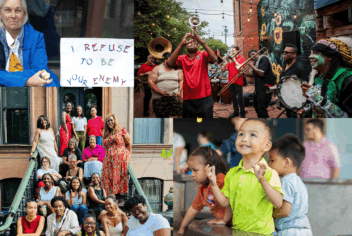This article was originally published on BlueAvocado.org as part of a special edition done in conjunction with Young Nonprofit Professionals Network (YNPN).
At first glance, nonprofits and millennials seem like a match made in heaven. Despite often being judged by our peers, our so-called “entitled” generation puts our desire for positive change above almost all else, seeking jobs that allow us to both do good and feel good.
According to a survey conducted by Deloitte, 60 percent of millennials look for purpose in their work, and 77 percent reported that their company’s purpose was a major factor in why they chose to work there.
With that in mind, it would seem that the nonprofit sector and millennials are indeed a perfect pair, and in this situation, nonprofits get innovative young professionals with a passion to make a difference, and millennials get the opportunity to use their skills to benefit the greater good.
It’s a win-win situation — or so it would seem.
Purpose vs. Paycheck
While it’s true that most millennials have the desire to work for a cause rather than just a paycheck, there’s one major factor that complicates this seemingly ideal relationship: The student loan crisis.
With student debt in the United States equaling more than $1.45 trillion and college graduates on average owing $37,000 in educational loans, it’s nearly impossible for millennials to choose a career without factoring in their educational debt, and unfortunately, when factoring in such debt, the nonprofit sector begins to look less appealing.
The student debt crisis, combined with the public perception that nonprofits have less-than-desirable salaries, function as a deterrent to millennials because in many ways, we believe we can have a more significant impact on our debt and our community if we choose to work for a for-profit company and find alternative ways to get involved.
The fact is, a large salary at a for-profit company can be more appealing than a stereotypically low nonprofit salary, even to those of us that have a desire to work for the greater good, because it gives us the ability to make student loan payments with ease and make substantial donations to the nonprofits that we care about, all with the financial stability that we seek.
This isn’t to say that millennials are motivated solely by money, but with student debt lingering over the heads of so many, it has an effect on the nonprofit sector’s ability to attract and retain millennial talent.
Why does this matter for nonprofit leaders?
Millennials are already the largest working generation in the U.S., which makes us increasingly important to nonprofit and for-profit employers alike, and with student debt as a factor, many choose to abandon nonprofit work despite their desire to do good. The problem does not just extend along the lines of age either; student debt also affects diversity.
According to a study conducted by CalNonprofits, “student debt results in a less diverse workforce; many of the nonprofit employees leaving the sector are those with larger student debt — first-generation college graduates, people of color, and women.”
Women hold nearly 65 percent of student debt, and pay back their loans at a slower rate than men, likely a result of the gender pay gap.
Minorities face similar issues, with black and Hispanic borrowers paying their loans back more slowly than white and Asian borrowers, often due to financial difficulties after graduation.
To make matters worse, minorities are already underrepresented in the nonprofit sector. In the U.S., only 20 percent of nonprofit board members are people of color, and while 73 percent of nonprofit employees are women, more than half of nonprofit leaders are men.
This presents an issue to nonprofits, as diversity is directly linked to creativity, innovation, and better overall performance.
As the Stanford Social Innovation Review puts it, “If we want to optimize the social sector’s potential to create impact, diverse nonprofit boards are not a ‘nice to have,’ they are a ‘must have.'”
If student debt disproportionally affects the very individuals that the nonprofit sector needs in order to better itself, and individuals with student debt become disinclined to work in the nonprofit sector, that presents a very real problem for nonprofit leaders.
How can nonprofits attract more young professionals?
Given how essential millennials are becoming to employers, and how perfect a match nonprofits and millennials can be, what can nonprofit leaders do to attract and retain more young professionals with debt? Below are some options for supporting staff:
- This many seem like a given, but pay close attention to the salaries and benefits being offered by your organization. When it comes to determining employee salaries, use benchmark data to ensure that you’re offering compensation that is on par with similar organizations, to the best of your organization’s ability. According to an article on EBN, many regional nonprofit associations collect this information to “help nonprofits ensure they’re offering a competitive salary for their job role and region.”
- Read up on the Public Service Loan Forgiveness Program. Stay informed about Public Service Loan Forgiveness eligibility requirements and find out if your nonprofit is a qualified employer. If so, make sure employees are aware of the requirements, as well as any updates to the program. Employees that do qualify are eligible for student loan forgiveness after 10 years of nonprofit employment — a major source of appeal for young employees with debt.
- Create a tuition reimbursement program for education related to the employee’s job function. This can help retain employees wishing to continue their education without increasing their debt.
- Pay attention to other factors of employment that attract young professionals, such as work-life balance. Factor in “soft benefits” such as company lunches, generous time off, and other factors that contribute to an employee’s overall wellness and satisfaction.
- Prioritize volunteer work so that your employees maintain a close connection to the cause. Facilitating and maintaining a hands-on relationship between your employees and your mission helps keep younger staff-members directly invested in the good of the work they’re doing.
It’s undeniable that nonprofits are a great fit for millennials, who have an innate desire to work towards a cause and to have an impact on their community.
While student debt can muddy this seemingly perfect relationship, making it a somewhat less desirable choice for some young professionals, the fact is that given the right circumstances, the two can still be a match made in heaven.





